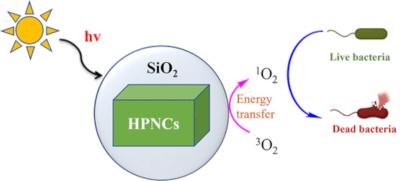Rice University researchers have developed highly water-stable SiO2-coated halide perovskite nanocrystals (HPNCs) as efficient photocatalysts for antimicrobial applications. The double SiO2 layer coating method confers long-term structural and optical stability to HPNCs in water, while the in situ synthesis of lead- and bismuth-based perovskite NCs into the SiO2 shell enhances their versatility and tunability.
Image from: Nano Letters
The team demonstrated that the substantial generation of singlet oxygen via energy transfer from HPNCs enables efficient photoinduced antibacterial efficacy under aqueous conditions. More than 90% of Escherichia coli was inactivated under mild visible light irradiation for 6 h. The excellent photocatalytic antibacterial performance suggests that SiO2-coated HPNCs hold great potential for various aqueous phase photocatalytic applications.
The new material is effective at killing bacteria in a biofluid under visible light without experiencing light- and moisture-driven degradation common in HPNCs and was developed over years of work.
HPNCs have unique optical and electrical properties that make them promising candidates for solar power applications, bioimaging and photocatalysis, the acceleration of chemical reactions caused by light in the presence of a catalyst. One such reaction is the production of reactive oxygen species that can inactivate biological contaminants in fluids. However, perovskites are highly prone to degradation in water and biological fluids, limiting their potential in biomedical applications.
"The drawback with these materials has been stability. They're cheap and easy to make but prone to degradation," said study co-author Jun Lou, professor and associate chair of materials science and nanoengineering.
The potential for HPNCs to eliminate contaminants from water has taken center stage in recent years with rising concerns about emerging pathogens and increasing rates of antibiotic resistance. Research has found that HPNCs can kill bacteria in aqueous environments by producing reactive oxygen species when exposed to light. Reactive oxygen species like singlet oxygen and hydroxide react with the proteins, lipids and genetic material in bacterial cells, effectively destroying them.
In their early attempts to produce a coated HPNC, the researchers used a single layer of silicon dioxide, a material that would protect the perovskite while allowing light transmission. However, a single layer had limited effectiveness with HPNCs losing 63% of their antimicrobial ability within one day. But a thicker layer could hinder or even prevent HPNCs' mechanism of action.
"Transfer of energy from perovskites can produce reactive oxygen species," said Zhu, a postdoctoral research associate in Lou's lab. "The challenge is to get the right thickness to protect the perovskite while still allowing energy transfer."
Zhu and colleagues next developed a method that coated the HPNCs in two layers of silicon dioxide. After multiple attempts the research team devised a strategy to consistently get optimal thicknesses for both layers.
"Two coats are more effective than one thicker coat," said Lou. "It's not just an extension of thickness. We needed a strategy because the coating has to be processed in specific ways."
Next the researchers tested the antimicrobial properties and durability of their new double-coated HPNCs. They selected lead and bismuth because HPNCs made with both metals are highly effective under visible light and produce singlet oxygen rather than hydroxide, which can be harmful to other organisms. Zhu and colleagues found that both HPNC varieties showed little to no antimicrobial properties without light. However, under relatively low levels of visible light, both HPNCs destroyed more than 90% of the E. coli bacteria in the solution after six hours. Additionally, both HPNCs showed very little degradation over the four-day test period.
The double-layer silicon dioxide coating proved effective at protecting HPNCs from degradation while allowing energy transfer; however, the researchers also noted an additional benefit from the coating. Analysis found that after four days in water, the lead-based HPNCs had leached only a small amount of lead into their surroundings.
"The leaching amount of lead was well below (World Health Organization) limits," Zhu said.
The lead-based HPNCs had the best antimicrobial performance, but the bismuth-based materials also performed well.
"The benefit of bismuth is avoiding the use of lead, which is always a concern if put into the body," said Lou. "You want to find the right balance with a material that has good enough performance and that is safe."
The study's findings show that HPNCs coated with two layers of silicon dioxide have the potential for use as photocatalytic antimicrobial agents. Eliminating organic contaminants like bacteria in water makes these materials a good candidate for use in water treatment. Further research could also lead to HPNCs that can address other water contaminants and even be used in therapeutics in the future. Such materials will need to undergo further testing under real-life conditions in the field and pass safety tests. However, the findings suggest that HPNCs could be useful in a variety of applications.
"After many years of investment in research into these materials, they are approaching reality," Lou said.




